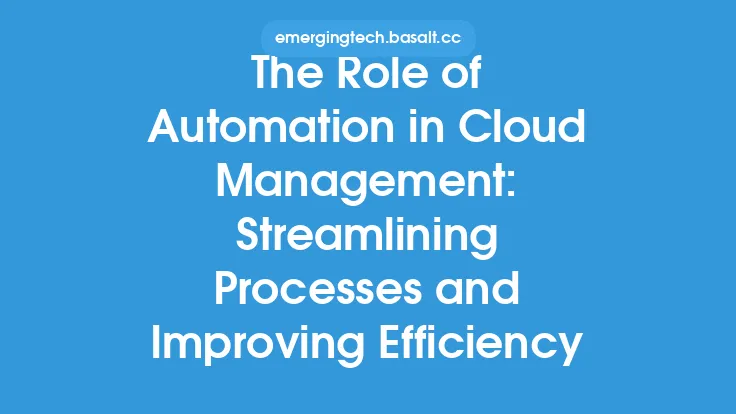The financial industry has witnessed a significant transformation in recent years, with the integration of machine learning (ML) and artificial intelligence (AI) in various aspects of wealth management. The rise of machine learning in wealth management has enabled the automation of various tasks, improved investment decisions, and enhanced the overall client experience. In this article, we will delve into the world of automating wealth management, exploring the role of machine learning, its applications, and the benefits it offers to both wealth management firms and their clients.
Introduction to Machine Learning in Wealth Management
Machine learning is a subset of artificial intelligence that involves the use of algorithms and statistical models to enable machines to perform tasks without being explicitly programmed. In the context of wealth management, machine learning can be applied to analyze large datasets, identify patterns, and make predictions about market trends and investment opportunities. This enables wealth management firms to provide personalized investment advice, optimize portfolio performance, and improve risk management. Machine learning algorithms can be broadly classified into two categories: supervised and unsupervised learning. Supervised learning involves training algorithms on labeled data to make predictions, while unsupervised learning involves identifying patterns in unlabeled data.
Applications of Machine Learning in Wealth Management
Machine learning has a wide range of applications in wealth management, including portfolio optimization, risk management, and investment advice. One of the primary applications of machine learning is in portfolio optimization, where algorithms can be used to analyze large datasets and identify the optimal asset allocation for a given investment objective. Machine learning can also be used to predict market trends and identify potential investment opportunities, enabling wealth management firms to provide proactive investment advice to their clients. Additionally, machine learning can be used to improve risk management by analyzing market data and identifying potential risks, enabling wealth management firms to take proactive measures to mitigate these risks.
Machine Learning Algorithms Used in Wealth Management
Several machine learning algorithms are used in wealth management, including decision trees, random forests, and neural networks. Decision trees are a type of supervised learning algorithm that involves creating a tree-like model to classify data and make predictions. Random forests are an extension of decision trees, involving the creation of multiple decision trees to improve the accuracy of predictions. Neural networks are a type of unsupervised learning algorithm that involves creating a network of interconnected nodes to identify patterns in data. These algorithms can be used to analyze large datasets, identify patterns, and make predictions about market trends and investment opportunities.
Benefits of Machine Learning in Wealth Management
The integration of machine learning in wealth management offers several benefits to both wealth management firms and their clients. One of the primary benefits is improved investment decisions, as machine learning algorithms can analyze large datasets and identify potential investment opportunities. Machine learning can also improve risk management by analyzing market data and identifying potential risks, enabling wealth management firms to take proactive measures to mitigate these risks. Additionally, machine learning can enhance the client experience by providing personalized investment advice and improving communication between wealth management firms and their clients.
Challenges and Limitations of Machine Learning in Wealth Management
While machine learning offers several benefits in wealth management, there are also several challenges and limitations to its adoption. One of the primary challenges is the availability of high-quality data, as machine learning algorithms require large datasets to make accurate predictions. Additionally, machine learning algorithms can be complex and require significant computational resources, which can be a challenge for smaller wealth management firms. There is also the risk of bias in machine learning algorithms, which can result in inaccurate predictions and poor investment decisions.
Future of Machine Learning in Wealth Management
The future of machine learning in wealth management is exciting and rapidly evolving. As the amount of data available continues to grow, machine learning algorithms will become increasingly sophisticated, enabling wealth management firms to provide more accurate investment advice and improve risk management. Additionally, the integration of machine learning with other technologies, such as blockchain and cloud computing, will enable wealth management firms to provide more secure and efficient services to their clients. However, as the use of machine learning in wealth management continues to grow, it is essential to address the challenges and limitations associated with its adoption, including the availability of high-quality data and the risk of bias in machine learning algorithms.
Best Practices for Implementing Machine Learning in Wealth Management
To implement machine learning in wealth management effectively, several best practices should be followed. First, it is essential to have a clear understanding of the business problem that machine learning is intended to solve. This involves defining the investment objectives and risk tolerance of clients, as well as the key performance indicators (KPIs) that will be used to measure the success of machine learning algorithms. Second, it is essential to have access to high-quality data, which involves collecting and cleaning large datasets and ensuring that they are relevant to the business problem. Third, it is essential to select the appropriate machine learning algorithm, which involves considering the type of data available and the complexity of the business problem. Finally, it is essential to monitor and evaluate the performance of machine learning algorithms continuously, which involves tracking KPIs and making adjustments as necessary.
Regulatory Environment for Machine Learning in Wealth Management
The regulatory environment for machine learning in wealth management is rapidly evolving, with several regulatory bodies issuing guidelines and regulations on the use of machine learning in financial services. In the United States, the Securities and Exchange Commission (SEC) has issued guidelines on the use of machine learning in investment advice, while in Europe, the European Securities and Markets Authority (ESMA) has issued guidelines on the use of machine learning in risk management. Additionally, several regulatory bodies have established sandboxes and innovation hubs to support the development of machine learning and other fintech technologies. It is essential for wealth management firms to stay up-to-date with the latest regulatory developments and ensure that their use of machine learning complies with relevant regulations and guidelines.
Conclusion
In conclusion, the rise of machine learning in wealth management has transformed the financial industry, enabling the automation of various tasks, improving investment decisions, and enhancing the client experience. While there are several challenges and limitations to the adoption of machine learning, the benefits it offers to both wealth management firms and their clients are significant. As the use of machine learning in wealth management continues to grow, it is essential to address the challenges and limitations associated with its adoption, including the availability of high-quality data and the risk of bias in machine learning algorithms. By following best practices and staying up-to-date with the latest regulatory developments, wealth management firms can harness the power of machine learning to provide more accurate investment advice, improve risk management, and enhance the client experience.





